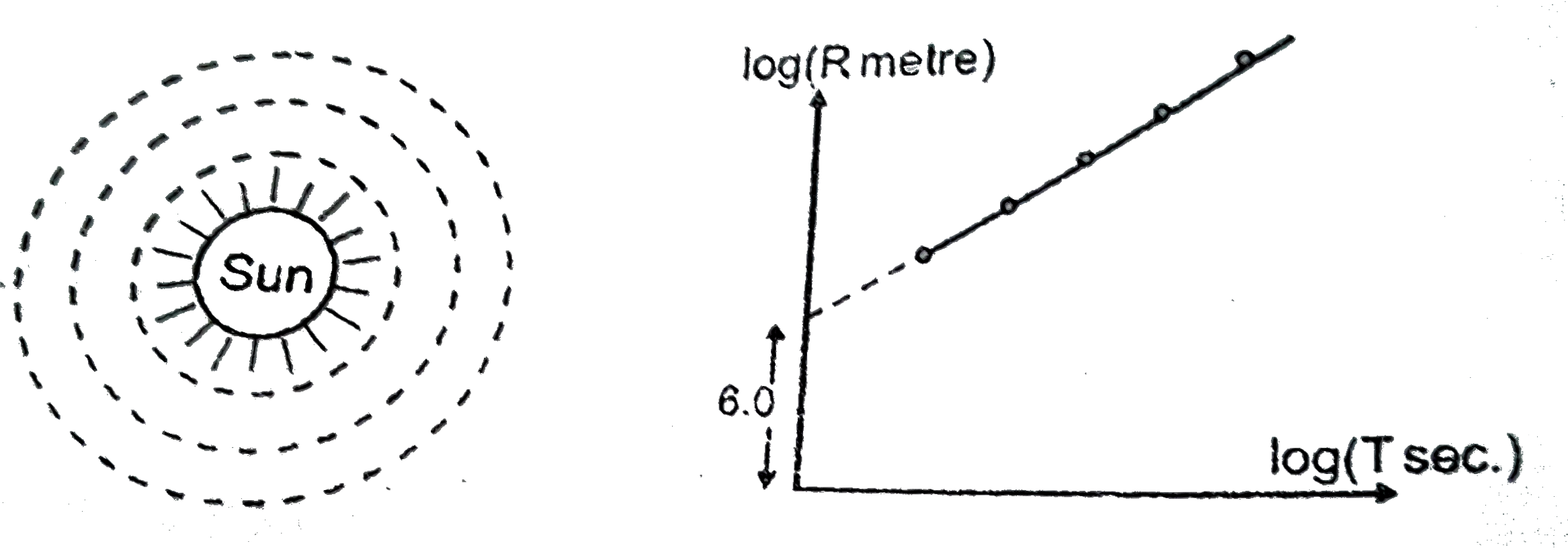If a planet of radius R and density D is revolving around the sun in a circular orbit of radius r with time period T, then the mass of the sun is
4π2r3GT
4π2r3GT2
4π2rGT
4π2r3G2T2
The correct Answer is:B
To find the mass of the Sun (M) given a planet of radius R and density D revolving around it in a circular orbit of radius r with time period T, we can follow these steps:
1. Use Kepler's Third Law: According to Kepler's Third Law, the square of the time period (T) of a planet is directly proportional to the cube of the radius (r) of its orbit around the Sun. This can be expressed mathematically as:
T2∝r3
This implies:
T2=k⋅r3
where k is a constant.
2. Apply Newton's Law of Gravitation: The gravitational force acting on the planet can be expressed using Newton's law of gravitation:
F=G⋅M⋅mr2
where G is the gravitational constant, M is the mass of the Sun, and m is the mass of the planet.
3. Centripetal Force: For a planet moving in a circular orbit, the centripetal force required to keep it in that orbit is given by:
F=mv2r
where v is the orbital velocity of the planet.
4. Equate the Forces: Since the gravitational force provides the necessary centripetal force, we can set the two expressions for force equal to each other:
mv2r=G⋅M⋅mr2
We can cancel m from both sides (assuming m ≠ 0):
v2r=G⋅Mr2
Rearranging gives:
v2=G⋅Mr
5. Relate Velocity to Time Period: The velocity (v) of the planet can also be expressed in terms of the time period (T):
v=2πrT
Squaring this gives:
v2=(2πrT)2=4π2r2T2
6. Substitute into the Equation: Now we can substitute this expression for v2 into the equation we derived from equating the forces:
4π2r2T2=G⋅Mr
7. Solve for Mass of the Sun (M): Rearranging this equation to solve for M gives:
M=4π2r3GT2
Final Expression:
Thus, the mass of the Sun (M) is given by:
M=4π2r3GT2
T2∝r3
This implies:
T2=k⋅r3
where k is a constant.
F=G⋅M⋅mr2
where G is the gravitational constant, M is the mass of the Sun, and m is the mass of the planet.
F=mv2r
where v is the orbital velocity of the planet.
mv2r=G⋅M⋅mr2
We can cancel m from both sides (assuming m ≠ 0):
v2r=G⋅Mr2
Rearranging gives:
v2=G⋅Mr
v=2πrT
Squaring this gives:
v2=(2πrT)2=4π2r2T2
4π2r2T2=G⋅Mr
M=4π2r3GT2
Thus, the mass of the Sun (M) is given by:
M=4π2r3GT2
Similar Questions
Many planets are revolving around the fixed sun in circular orbits of different radius (R) and difference time period (T) To estimate the mass of the sun the orbital radius (R) and time period (T) of planets were noted. Then log10 T v/s log10R curve was plotted.
The curve was found to be approximately straight line (as shown in) having y intercept =6.0 (Neglect the gravitational interaction among the planets) [Take G=203×10−11 in MKS, π2=10]

The slope of the line should be .
View SolutionIf L is the angular momentum of a satellite revolving around earth is a circular orbit of radius r with speed v , then
View Solution
Knowledge Check
If a planet revolves around the sun in a circular orbit of radius a with a speed of revolution T, then (K being a positive constant
AT=Ka2/3BT=Ka3/2CT=Ka2DT=Ka3Imagine a light planet revolving around a very massive star in a circular orbit of radius R with a period of revolution T. if the gravitational force of attraction between the planet and the star is proportational to R−5/2, then
(a) T2 is proportional to R2
(b) T2 is proportional to R7/2
(c) T2 is proportional to R3/3
(d) T2 is proportional to R3.75.AR3/2BR3/5CR7/2DR7/2
A small planet is revolving around a massive star in a circular orbit of radius R with a period of revolution T. If the gravitational force between the planet and the star were proportional to R−5/2, then T would be proportional to
View SolutionA small planet is revolving around a massive star in a circular orbit of radius R with a period of revolution T. If the gravitational force between the planet and the star were proportional to R−5/2, then T would be proportional to
View SolutionImagine a light planet revolving around a very massive star in a circular orbit of radius r with a period of revolution T. On what power of r will the square of time period will depend if the gravitational force of attraction between the planet and the star is proportional to r−5/2.
View SolutionA satellite is revolving round the earth in an orbit of radius r with time period T. If the satellite is revolving round the earth in an orbit of radius r+Δr(Δr<<r) with time period T+ΔT(ΔT<<T) then.
View SolutionExplain the motion of a planet around the sun in a circular path?
View SolutionImagine a light planet revolving around a very massive star in a circular orbit of radius R with a period of revolution T. if the gravitational force of attraction between the planet and the star is proportational to R−5/2, then
(a) T2 is proportional to R2
(b) T2 is proportional to R7/2
(c) T2 is proportional to R3/3
(d) T2 is proportional to R3.75.
View Solution
